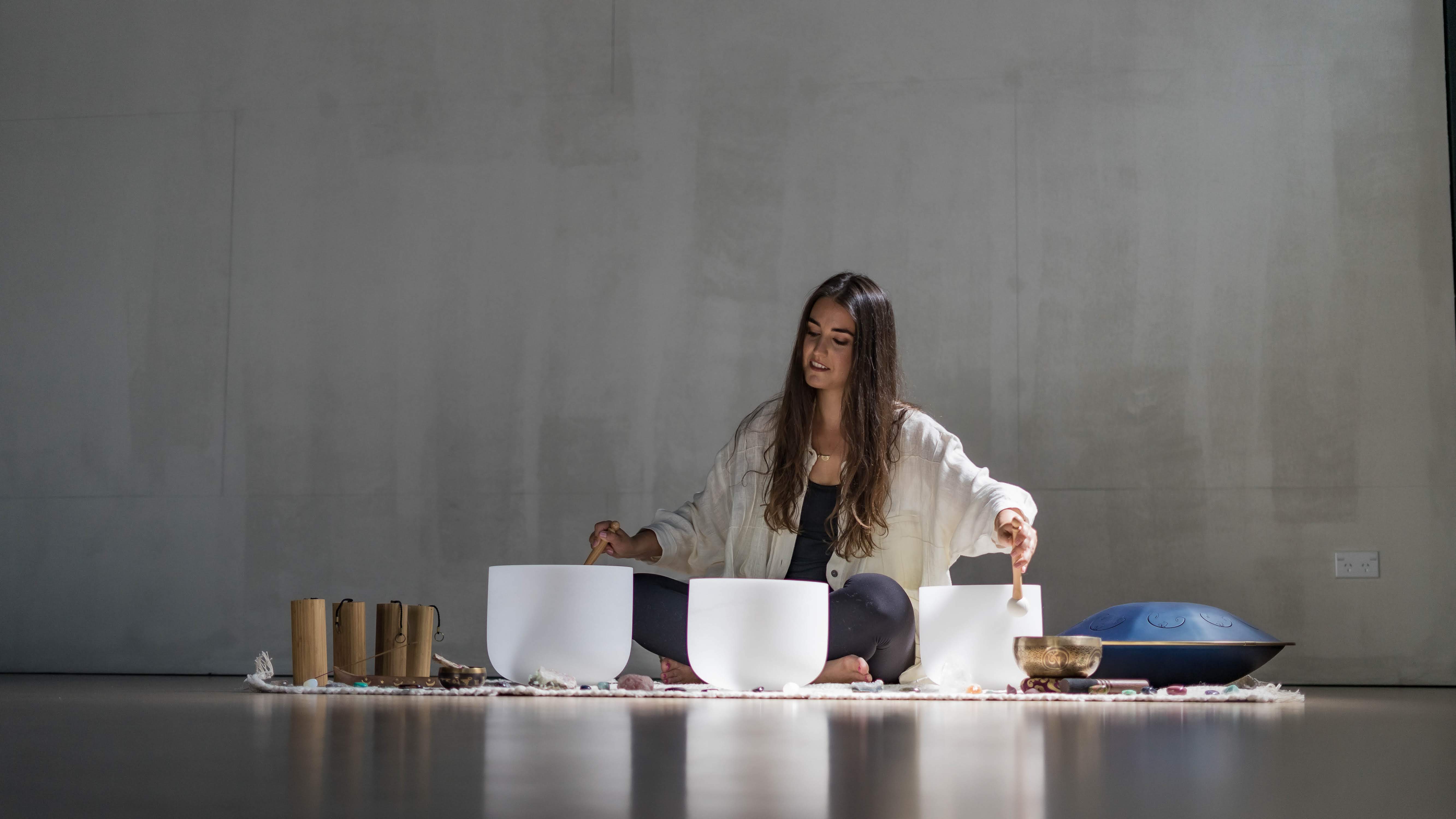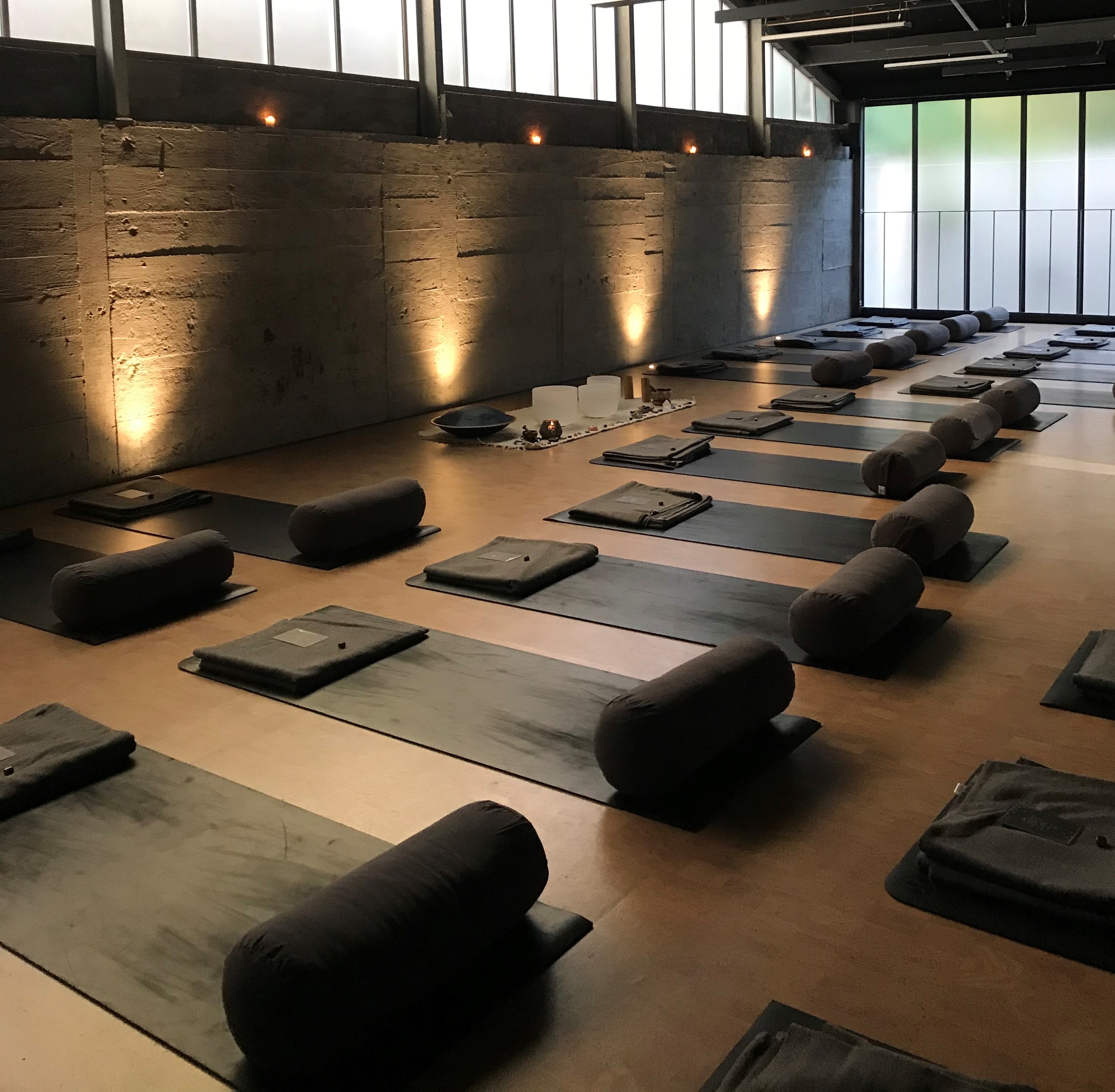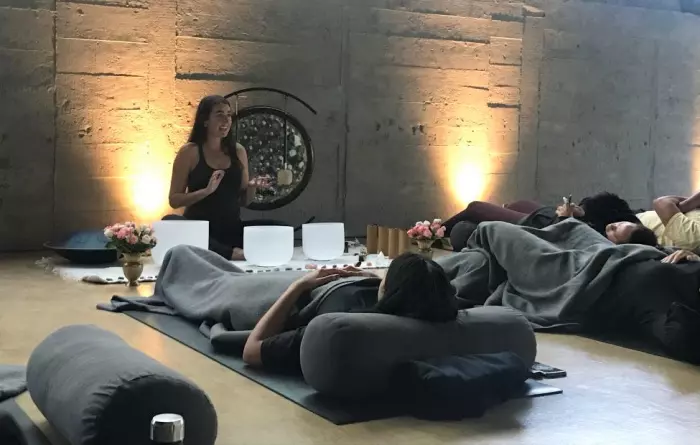Sound bath is not a term you hear often, but a quick search online will likely show classes or workshops near you. It is essentially a form of mediation, but a practitioner creates different ambient sounds to help you achieve a deeply relaxed meditative state.
You might scoff, but bear in mind you probably already experience some form of music therapy in your daily routine – a particular artist you listen to while on a run, or there might be a genre you’ll shuffle on Spotify while you cook dinner. Music therapy is also used as a sleep aid and a therapy tool.
Studies show that sound healing helps with myriad health issues, such as reducing the heart rate and slowing the breath rate, lowering blood pressure, easing stress, lessening depression symptoms, reducing fatigue and relaxing in general.
Sophie Correia runs sound-bath sessions at Auckland’s Crossing Paths, based at the Basecamp Power Yoga studio in Grey Lynn. She has put together a fully immersive experience in which a room full of strangers lie in rows in what looks like a giant slumber party. People of all ages and genders attend in all sorts of attire (pyjamas are encouraged), which dashes any preconceived notion that sound baths might cater only to the freer spirits among us.
 Sophie Correia playing instruments used during the sound bath
Sophie Correia playing instruments used during the sound bath
It is worth keeping an open mind during the sound bath, especially for cynics like me and probably anyone reading a business news website. While some aspects of the experience feel a bit too metaphysical initially, trusting the instructor and going with the flow will pay dividends by the end of the session.
‘Bathers’ lie with their eyes closed on yoga mats adorned with pillow and blankets. Correia begins the sound-bath experience by explaining the instruments before her at the front of the room, and the sorts of sounds participants can expect to hear during the bath. The smells in the room are also introduced, such as sage from a smudging ceremony performed before the class to cleanse the space, the Japanese incense burning throughout the session, and lavender mist to conclude.
Starting with a guided meditation, Correia walks through the studio describing the three chakras the session will be directed towards: the root chakra, the heart chakra, and the third-eye chakra. Each is associated with a particular colour of light: a warm orange glow rests in the base of the spine, the root chakra; calm and peaceful jade sits in the heart; and a pale indigo glows between the eyes in the third-eye chakra.
Each light colour has a particular wavelength, and with it, a frequency. The ethereal sounds created during the bath are chosen intentionally to vibrate at the same frequencies as the designated chakra. Any time your mind wanders during the sound bath, Correia encourages you to come back to these lights.
 The Crossing Path's sound bath space
The Crossing Path's sound bath space
This may sound airy-fairy, though it is anything but. The sheer volume of the sounds Correia creates makes it not so much a sound bath as a sonic soaking. It is loud. Using three rose quartz crystal bowls, differently sized to target the chakra frequencies, Correia employs a striking stick to beat and whir the bowls into life.
The sounds are designed to make the body vibrate – the lower spine buzzing with the low frequencies, the nose stinging at a higher frequency.
Additional sounds spread through the room and Correia moves from one instrument to another, including a metal Tibetan singing bowl, a cinematic drum, an Earth gong, and a Rav Vast – a steel hand pan which is a drum that combines the appearance of a flying saucer and a turtle shell. The session finishes with the delicate twinkling of wooden wind chimes, which Correia flutters over each body to rouse the bather back to alertness.
The impact of the sound bath differs from person to person, some experiencing relief, elation or revitalisation, others feeling peace, reflection or sorrow. All these feelings are valid and welcome in the session.
Some participants even fall asleep during the bath, although snores aren’t one of the intended sounds and their neighbours are asked to give them a gentle nudge.
The least you will come away from a sound bath with is a feeling of relaxation, an assurance you will sleep well that night, and an appreciation that you’ve taken time to put the mind and body first after a difficult year.
A sound bath is particularly suitable for those who are new to meditation, or perhaps have tried a few times but struggle with a wandering mind. The sound bath renders you passive to the experience; you simply lie there and let the sounds do the work, as opposed to actively focusing on your breath or body during standard meditation.
It’s a harmonious way to welcome good vibes into 2021.
crossingxpaths.com
Sound baths are held twice monthly.














